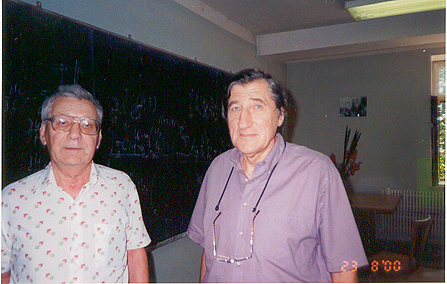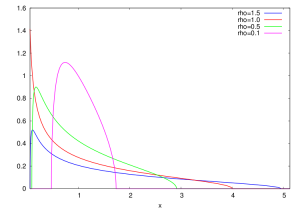The Marchenko – Pastur law \( {\mu_\rho} \) with shape parameter \( {\rho>0} \) is the probability distribution
\[ \left(1-\frac{1}{\rho}\right)_+\delta_0+\frac{1}{\rho 2\pi x}\sqrt{(b-x)(x-a)}\,\mathbf{1}_{[a,b]}(x)dx \]
where
\[ a=(1-\sqrt{\rho})^2 \quad\text{and}\quad b=(1+\sqrt{\rho})^2. \]
It has mean \( {1} \) and variance \( {\rho} \). It has an atom at point \( {0} \) if and only if \( {\rho>1} \).
Lemma 1 (Moments of the Marchenko-Pastur law) For all \( {r\geq1} \),
\[ \int\!x^r\,d\mu_\rho(x) =\sum_{k=0}^{r-1}\frac{\rho^k}{k+1}\binom{r}{k}\binom{r-1}{k}. \]
Proof: Since \( {a+b=2(1+\rho)} \) and \( {ab=(1-\rho)^2} \) we have
\[ \sqrt{(b-x)(x-a)} =\sqrt{\frac{(a+b)^2}{4}-ab-\left(x-\frac{a+b}{2}\right)^2} =\sqrt{4\rho-(x-(1+\rho))^2} \]
The change of variable \( {y=(x-(1+\rho))/\sqrt{\rho}} \) gives
\[ \int\!x^r\,d\mu_\rho(x) =\int\!x^r\,d\mu_\rho(x) =\frac{1}{2\pi} \int_{-2}^2\!(\sqrt{\rho}y+1+\rho)^{r-1}\sqrt{4-y^2}\,dy. \]
Recall that the moments of the semicircle law are given by the Catalan numbers :
\[ \frac{1}{2\pi}\int_{-2}^2\!y^{2k+1}\,\sqrt{4-y^2}\,dy =0 \quad\text{and}\quad \frac{1}{2\pi}\int_{-2}^2\!y^{2k}\,\sqrt{4-y^2}\,dy =\frac{1}{1+k}\binom{2k}{k}. \]
This gives, by using binomial expansions and Vandermonde’s identity
\[ \begin{array}{rcl} \int\!x^r\,d\mu_\rho(x) &=&\sum_{k=0}^{\lfloor(r-1)/2\rfloor} \rho^k(1+\rho)^{r-1-2k}\binom{r-1}{2k}\binom{2k}{k}\frac{1}{1+k}\\ &=&\sum_{k=0}^{\lfloor(r-1)/2\rfloor} \rho^k(1+\rho)^{r-1-2k}\frac{(r-1)!}{(r-1-2k)!k!(k+1)!}\\ &=&\sum_{k=0}^{\lfloor(r-1)/2\rfloor} \sum_{s=0}^{r-1-2k} \rho^{k+s}\frac{(r-1)!}{k!(k+1)!(r-1-2k-s)!s!}\\ &=&\sum_{t=0}^{r-1}\rho^t\sum_{k=0}^{\min(t,r-1-t)} \frac{(r-1)!}{k!(k+1)!(r-1-t-k)!(t-k)!}\\ &=&\frac{1}{r}\sum_{t=0}^{r-1}\rho^t\binom{r}{t}\sum_{k=0}^{\min(t,r-1-t)} \binom{t}{k}\binom{r-t}{k+1}\\ &=&\frac{1}{r}\sum_{t=0}^{r-1}\rho^t\binom{r}{t}\binom{r}{t+1} \\ &=&\sum_{t=0}^{r-1}\frac{\rho^t}{t+1}\binom{r}{t}\binom{r-1}{t}. \end{array} \]
☐ The Marchenko-Pastur law appears in the famous Marchenko-Pastur theorem. Namely, let \( {X_1,\ldots,X_n} \) be independent and identically distributed random column vectors of \( {\mathbb{R}^m} \), with mean \( {0} \) and covariance matrix \( {I_m} \). Let us consider the \( {m\times m} \) empirical covariance matrix
\[ \frac{1}{n}\sum_{i=1}^nX_iX_i^\top=\frac{1}{n}YY^\top \quad\text{where}\quad Y=\left(X_1\cdots X_n\right). \]
We have \( {\mathbb{E}(\frac{1}{n}YY^\top)=I_m} \) and the strong law of large numbers indicates that with probability one,
\[ \lim_{n\rightarrow\infty}\frac{1}{n}YY^\top = I_m. \]
What happens if \( {m} \) grows with \( {n} \)? Let us assume for simplicity that the components of \( {X_1} \) are independent (automatic if \( {X_1} \) is Gaussian).
Theorem 2 (Marchenko-Pastur) Suppose that \( {m=m_n} \) depends on \( {n} \) is such a way that
\[ \lim_{n\rightarrow\infty}\frac{m_n}{n}=\rho\in(0,\infty). \]
Let \( {\lambda_{n,1},\ldots,\lambda_{n,m_n}\in[0,\infty)} \) be the eigenvalues of the \( {m_n\times m_n} \) empirical covariance matrix \( {\frac{1}{n}YY^\top} \), and let us consider the empirical spectral distribution
\[ \mu_n:=\frac{1}{m_n}\sum_{k=1}^{m_n}\delta_{\lambda_{n,k}}. \]
Then with probability one, for every bounded continuous \( {f:\mathbb{R}\rightarrow\mathbb{R}} \),
\[ \lim_{n\rightarrow\infty}\int\!f\,d\mu_n=\int\!f\,d\mu_\rho \]
In other words, with probability one, for every \( {x\in\mathbb{R}} \) (\( {x\neq0} \) if \( {\rho>1} \)), denoting \( {I=(-\infty,x]} \),
\[ \lim_{n\rightarrow\infty}\mu_n(I)=\mu_\rho(I). \]
Note that
\[ \int\!x\,d\mu_n=\frac{1}{m_n}\sum_{k=1}^{m_n}\lambda_{n,k} =\frac{1}{m_n}\mathrm{Tr}\left(\frac{1}{n}YY^\top\right) =\frac{1}{nm_n}\sum_{\substack{1\leq i\leq m_n\\1\leq j\leq n}}Y_{ij}^2 \]
and thus, by the strong law of large numbers, with probability one,
\[ \lim_{n\rightarrow\infty} \int\!x\,d\mu_n = 1 =\int\!x\,d\mu_\rho(x). \]
This shows the almost sure convergence of the first moment. It shows also that the sequence \( {{(\mu_n)}_{n\geq1}} \) is tight with probability one since by Markov’s inequality, for all \( {r>0} \),
\[ \mu_n([0,r]^c) \leq \frac{1}{r}\int\!x\,d\mu_n. \]
The Marchenko-Pastur theorem can be proved by using the method of moments or the Cauchy-Stieltjes resolvent method. In the Gaussian case, one may also use orthogonal polynomials (in this case the empirical covariance matrix belongs to the Laguerre Ensemble and its law is Wishart). Useful references include the recent book by Bai and Silverstein and the forthcoming book of Pastur and Shcherbina. Regarding orthogonal polynomials, there is a differential operator approach due to Haagerup and Thorbjørnsen, developped by Ledoux, in which the Marchenko-Pastur distribution is recovered as a mixture of a uniform and arcsine distributions. In free probability theory, the Marchenko-Pastur law is known as the free Poisson law, see for instance the book by Nica and Speicher or the book by Hiai and Petz.
If \( {\rho=1} \) then \( {\frac{1}{n}YY^\top} \) is asymptotically square, \( {a=0} \), \( {b=4} \), and the change of variable \( {t\mapsto\sqrt{t}} \) shows that with probability one, the empirical spectral distribution of
\[ \sqrt{\frac{1}{n}YY^\top} \]
converges as \( {n\rightarrow\infty} \) to the quarter circle law with density
\[ \frac{1}{\pi}\sqrt{4-x^2}\,\mathbf{1}_{[0,2]}(x)dx. \]
Concerning the support of the spectrum, one may first order the spectrum of \( {\frac{1}{n}YY^\top} \) as follows:
\[ \lambda_{n,1}\geq\cdots\geq\lambda_{n,m}. \]
Note that \( {\lambda_{n,k}=0} \) if \( {k>\min(m,n)} \). We have then the following:
Theorem 3 (Bai-Yin) Under the assumptions of the Marchenko-Pastur theoren and if additionnaly \( {X_{11}} \) have a finite fourth moment then with probability one
\[ \lim_{n\rightarrow\infty}\lambda_{n,\min(m,n)}=b \quad\text{and}\quad \lim_{n\rightarrow\infty}\lambda_{n,1}=a. \]
The Marchenko-Pastur theorem remains valid even if \( {X_{11}} \) does not have a zero mean, in contrast with the Bai-Yin theorem which fails in that case. The edge of the spectrum of \( {\frac{1}{n}YY^\top} \) is sensitive to finite rank perturbations of \( {Y} \) while the bulk of the spectrum is not, asymptotically.
Dimensional noise. The Marchenko-Pastur law has mean \( {1} \) and variance \( {\rho} \). It is enlightening to set \( {1_\pm=(1\pm\sqrt{\rho})^2} \), making apparent that the support \( {[a,b]=[1_-,1_+]} \) of the Marchenko-Pastur law is an interval around the mean \( {1} \), which is the spectrum of the population covariance matrix \( {I_m} \). This noise is a high dimensional effect due to the fact that \( {m} \) as well as \( {n} \) go to infinity.
Quarter circular law. If \( {\rho=1} \) then \( {[1_-,1_+]=[0,4]} \) and the Marchenko-Pastur law becomes
\[ \frac{\sqrt{4-x}}{2\pi\sqrt{x}}\mathbf{1}_{x\in[0,4]}\mathrm{d}x, \]
and its image by the map \( {x\mapsto\sqrt{x}} \) in this case is then the quartercircle law
\[ \frac{\sqrt{4-x^2}}{\pi}\mathbf{1}_{x\in[0,2]}\mathrm{d}x. \]
Shape parameter. The image of the Marchenko-Pastur law by the map \( {x\mapsto\frac{x-(1+\rho)}{\sqrt{\rho}}} \) is
\[ \frac{\sqrt{4-x^2}}{2\pi(1+\rho+\sqrt{\rho}x)}\mathbf{1}_{x\in[-2,2]}\mathrm{d}x, \]
which reveals that \( {\rho} \) is a shape rather than a scale parameter around the mean. This makes also apparent the convergence to the Wigner semicircle law as \( {\rho\rightarrow0} \).


Cher Pr. Chafaï
Je suis biologiste et je trvaille notemment en modélisation en evolution (adaptation, selection naturelle genetique des populations). Pour mes modèles j’utilise notemment des matrices aleatoires pour décrire des grands ensemble de straits phénotypiques interdépendants. J’utilise principalement la sample covariance matrix et votre remarque au bas de cette page m’interesse. Je constate en effet que dans mes simulations, si j’autorise X_11 à avoir une moyenne non nulle, j’obtiens: 1 valeur propre maxi qui est fortement superieure à toutes les autres (d’autant que X_11 a une grande moyenne) et un ensemble de valeurs propres qui elles, suivent la loi de marçenko pastur qu’on attendrait si X_11 etait de moyenne nulle. Ce résultat est potentiellement très utile pour moi et j’aimerais en trouver une description/preuve analytique (notemment la valeur de la valeur propre dominante unique). Connaissez vous la literature pertinente? Je n’ai pas vu de résultat là dessus dans le dernier livre de Bai et silverstein, mais je ne l’ai pas lu assez en detail, et je ne suis passez competent pour comprendre la plupart des preuves. Pour le moment je me borne donc à travailler avec le cas X_11 de moyenne nulle car je connais l’analytique dans ce cas (la loi MP), mais il est clair que mes resultats seraient bien plus generaux si je pouvais autoriser X_11 à prendre une moyenne arbitraire. Je vous remercie de votre aide
Cordialement
Guillaume Martin
PS: merci pour ce blog fort interessant !
Dear Pr. Chafaï,
I do not know what I did wong but my coment does not appear.
I work in biology modelling and use large random covariance matrices to describe phenotypic interactions. Your last coment at the bottom of this page interested me in particular: in my simulations, when I let X_11 have non zero mean, I get a single leading eigenvalue that is much larger than all others, and then all remaining eigenvalues follow the marçenko pastur law expected if X_11 had zero mean. I have looked for an analytic description and proof of this but did not find it (even in the recent Bai Silverstein 2010 book, but I may have read it too superfically). Would you recommend any paper on that matter?
I thank you for your help and for this very interesting blog
Best wishes
Guillaume
Dear Guillaume,
The Marchenko-Pastur theorem remains valid if the mean is not zero. By allowing a non zero mean, you are perturbing your model additively by a rank one matrix of growing norm. Such perturbations produce a single outlier and are very well understood (intuitively, you must see the model as an additive noise around a rank one matrix). More generally, you may perturb additively by a more general finite rank matrix, possibly depending on the dimensions. These models are known in the literature as spiked population models (search these keywords!), studied by Bai, Baik, Benaych-Georges, Johnstone. Silverstein, Yao, etc. You may take a look at a relatively recent paper by my colleague Loubaton and references therein.
Best.
Thank you for this help, I am starting to find the necessary results, I will have to work them out a bit but I should end up finding my result. What I need to compute is the eigenvalue that associated with the unit rank perturbation matrix. I found this recent paper
http://arxiv.org/pdf/1103.2221v2.pdf
which seems to derive fairly general results in terms of integral transforms and provides as an example my particular question.
Many thanks again for your help.
Best wishes
Guillaume
The moments of the Marchenko-Pastur distribution are related to Marayana numbers which are famous numbers in combinatorics.
Dear Professor Chafaï,
I have seen a very recent publication in Numerical Algorithms (related to Marchenko- Pastur law). Since this blog is the first reference in the paper, and a public place to discuss, I would like to comment:
%%%%
“Orthogonal polynomials relative to a generalized Marchenko–Pastur probability measure”
https://link.springer.com/article/10.1007/s11075-021-01073-1
%%%
The fact is that I cannot see it as a generalization of the Marchenko-Pastur law, but rather as a reformulation (or refutation) of it.
In my opinion, the point is that the Dirac delta measure (for the case c greater than one of Section 3) should have no role in the evaluation of the integrals (it seems so in the classical references), but this paper uses the Dirac measure for the orthogonal polynomial computations…
I would like to read here some comments from the experts as yourself (I am only an amateur).
Thank you for your work.